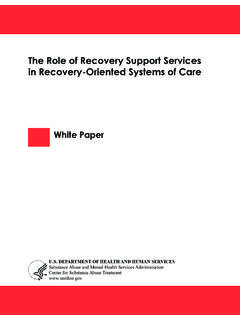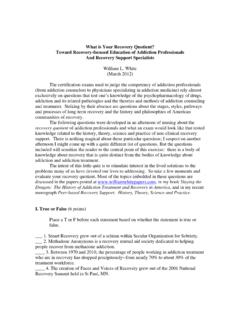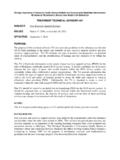Transcription of NETWORK THERAPY: Using Family and Peer Support To …
1 NETWORK THERAPY: Using Family and peer Support To Improve your treatment outcome Marc Galanter, Director, Division of Alcoholism and Drug Abuse Professor of Psychiatry New York University Medical Center 550 First Avenue New York, New York 10016 Phone: (212) 263-6960 Fax: (212) 263-8285 ABSTRACT It is a pleasure to present this treatment model in the first issue of "International Addiction." It is designed to help clinicians better manage their patients and has been found useful in many national settings.
2 In order to direct this at the clinician s needs, I have made this article brief and straightforward. The references at the end offer recourse to further printed material. Managing an addicted patient in office practice can be difficult in terms of the denial of illness they present and their tendency to relapse and become non-compliant. In order to overcome this, the clinician needs to draw on resources available in the patient s immediate environment. One way to do this is to engage Family and friends in parallel with individual counseling to bolster therapeutic engagement.
3 A supportive group of people close to the patient can provide valuable help in rehabilitating an addicted person, employing an approach called NETWORK Therapy, a pragmatic multimodal format for treatment (1). In Using this approach, a small group of specific Family members and friends are enlisted to provide ongoing Support and to promote attitude change. NETWORK members are part of the therapist's working "team," and not subjects of treatment themselves. The goal of this approach is the prompt achievement of abstinence with relapse prevention and the development of a drug-free adaptation.
4 The need for this approach arises from the confounding problem that physicians have only a marginal ability to influence their patients' behavior outside the office. If an addicted patient has a slip into drug abuse, his therapist may not be apprised, and even if he has found out, he can bring little influence to bear. A physician on his own is limited in the degree to which he can make demands on the patient's life, and the patient is free to walk away from the therapeutic situation if it is uncomfortable for him, that is to say, if it challenges a potential relapse to addiction.
5 All these factors make the engagement and orchestration of Family and friends into the therapy with a substance-abusing patient an invaluable resource, one which offers remarkable opportunity for the modification of traditional office techniques for treating the substance abuser (2-4). CONFRONTING THE PROBLEM We can make the nature of this option more clear with the example of one particular patient. A consulting physician was contacted by Paul, a physician practicing at a local hospital, who was concerned that the woman he hoped to marry was alcoholic.
6 As he explained, when they were getting to know each other, there were periods when Ann, seemingly functioning well, was unavailable in person or by phone. It was only after they moved in together that he realized the reason for these periods of absence, as he became aware that Ann would regularly go on drinking binges, and that she sometimes did not show up the next day at the law office where she worked. She once threatened to kill herself when she was drunk. Paul turned to her parents, but they preferred to minimize the issue, apparently not wanting to tarnish their daughter's image.
7 He pleaded with Ann to go to Alcoholics Anonymous (AA); she said she would think about it. Ann had been in treatment for a few years with a reputable general psychiatrist, who had unsuccessfully tried to convince her to stop drinking. At Paul's request, she came to the consultant for an alcoholism consultation, but said that she was quite comfortable in her current analytic treatment , and that it was offering her valuable insights. Furthermore, she did not think it useful for the consultant to speak directly with her doctor.
8 When it was pointed out that her continued drinking argued for additional intervention, or at least some visits to AA, she fell back on the contention that her relationship in therapy should be enough to deal with her problems. A few months after this initial meeting, Ann became annoyed at her physician for "pestering her" about going to AA and dropped out of treatment . The drinking continued unabated, and later that year she lost her job at the law office because of her unreliability. Paul was ready to walk out as well but said he would give her one more chance if she saw the consultant, "the doctor who said she had to stop drinking.
9 " This time, she acknowledged in the consultation that it was reasonable for her to get some Support to help her look at her situation, and the consultant asked her to bring Paul and a friend of hers to the next session to discuss the issue. This was the beginning of her NETWORK Therapy. The two NETWORK members, Paul and her friend, were certainly more revealing about the extent of Ann's alcoholism than she had been. They described how it now often left her in awkward social situations, and incapacitated as well in facing the day that would follow her heavy drinking.
10 The consulting psychiatrist now encouraged Paul and the friend to voice their feelings and concerns, to soften her inclination to avoid the problem. The impact of their orchestrated input moved Ann to acknowledge that she had a problem with alcohol. The NETWORK members helped to prevail on her to accept the idea of abstinence. Together, all four developed a regimen to Support her recovery, one that included individual sessions as well as meetings with this NETWORK . AA meetings were added as well, and the NETWORK members supported her in attending the meetings during later sessions, when she expressed misgivings about them.






